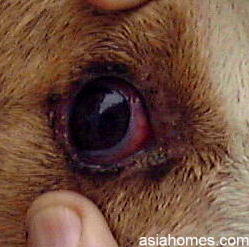| The stray
dog has blood-shot eyes
 The
one and a half year old male guard dog of the factory in the industrial park had blood-shot
eyes. He coughed and sneezed out abundant amount of mucus, staining his
front legs. Dirt from the soil pasted onto the mucus. The
one and a half year old male guard dog of the factory in the industrial park had blood-shot
eyes. He coughed and sneezed out abundant amount of mucus, staining his
front legs. Dirt from the soil pasted onto the mucus.
His eyes were infected by germs. Now they produced thick tears which solidified
quickly under the hot and humid weather of Singapore, forming a matted
crust ringing around the
eyelids.
 His
sclera (eye white) was red rather than the normal white as small bundles
of fine blood vessels proliferated to fight the infectious disease. The
blood vessels reinforced with white blood cells to combat the bacteria and
viruses. His
sclera (eye white) was red rather than the normal white as small bundles
of fine blood vessels proliferated to fight the infectious disease. The
blood vessels reinforced with white blood cells to combat the bacteria and
viruses.
"What is the problem with this stray dog?" asked Mr Lam, the industrial park
factory worker as he placed the dog on the examination table.
 The
dog was very sleepy and wobbly, as if he did not have enough sleep.
His
nostrils dripped strands of thick yellowish pus and red blood. The
dog tried to wipe it off but the profuse amount of discharge overwhelmed him. The
dog was very sleepy and wobbly, as if he did not have enough sleep.
His
nostrils dripped strands of thick yellowish pus and red blood. The
dog tried to wipe it off but the profuse amount of discharge overwhelmed him.
He had gone to Mr Lam, the kind factory worker who
would always fed him the leftover chicken bones and rice. Since he was a
factory guard dog, the proprietor had instructed him to get the dog
treated by a veterinarian.
I said: "This is a serious upper respiratory tract infection.
Most likely a viral with a secondary bacterial
infection." The factory worker looked at me blankly as the terms were
too technical.
I continued: "The dog has an infection in its nose and upper part of his
breathing tubes." I hoped he could understand that.
I inserted
rectal thermometer inside the dog's rectum. The temperature readings jumped
sharply from 0 to 41 degree Celsius in less than ten seconds. At 41 degrees, there would be severe damage to the brain cells, but this
dog was still alive.
At 41 degrees, there would be severe damage to the brain cells, but this
dog was still alive.
"When did the dog first become ill?" I asked the factory
worker.
"I don't know," the man said. "The dog comes and goes as he likes.
He had got worse the last few days." This would be the stray
dog with no owner. Stray dogs do die and though he felt sorry for them, he
was not distressed by their plight.
The dog was definitely not vaccinated to be protected against the
distemper virus. I wanted to take a blood sample for examination,
but the cost of treatment would increase and the patient would not be
around for follow up. I knew I would never see him again as stray
dogs don't get a second treatment.
Eye drops and antibiotics against the secondary bacterial infection were given. Would he recover from this viral infection?
Much depended on his immune system. As long as the virus did not
establish itself in his brain tissues, he would have a good chance to
recover as he was older compared to puppies. Puppies usually die
from distemper viral infections.
Freedom for a stray og in Singapore comes at a high price - the risk
of viral infections from other dogs as they muzzle each other during
meetings , being knocked down by cars as they
crossed the expressway. There used to be a roving band of government dog shooters
with shot guns to be aware of in the 1990s. Being born free was not good for stray
dogs in Singapore as they do not benefit from the effective distemper
vaccinations.
Singapore
canine distemper factory dog, pet health and welfare educational for
animal lovers Asiahomes'
Be Kind To Pets,
sponsored by AsiaHomes
Internet.
Copyright:
asiahomes.com
23 Jun 2003
|